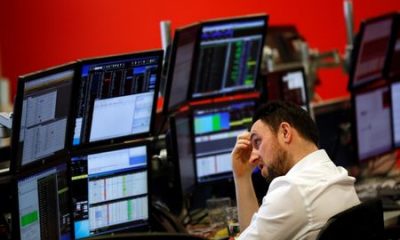Forex
Dollar dips on weak data, yen hurt by cautious BOJ
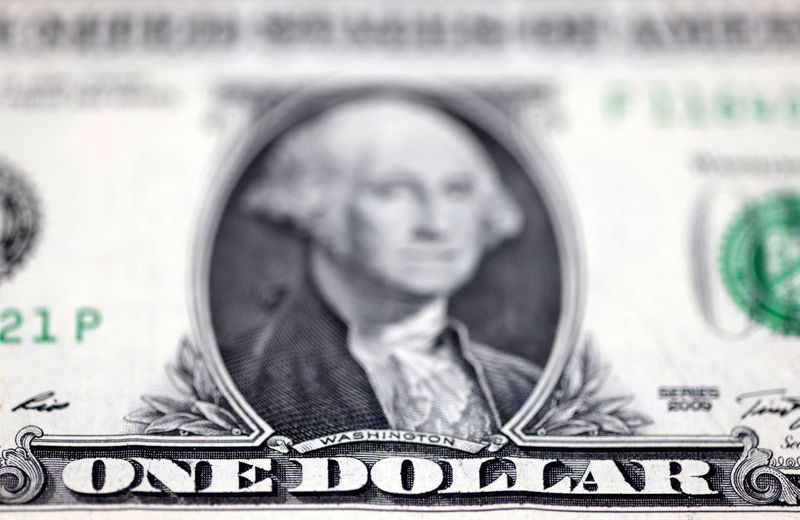

© Reuters. FILE PHOTO: U.S. Dollar banknote is seen in this illustration taken July 17, 2022. REUTERS/Dado Ruvic/Illustration/File Photo
By Karen Brettell
NEW YORK (Reuters) -The dollar fell against the euro on Friday on weaker than expected U.S. economic data but gained against the Japanese yen after Bank of Japan (BOJ) governor Kazuo Ueda said it was too soon to declare victory on inflation.
In cryptocurrencies, bitcoin held just below a more than two-year high reached on Wednesday.
U.S. manufacturing slumped further in February, with a measure of factory employment dropping to a seven-month low amid declining new orders. Construction spending, which had been expected to increase, also fell in January.
Economists at Goldman Sachs cut their gross domestic product (GDP) estimate for the first quarter by 0.2 percentage points to 2.2% after the data.
The dollar has been largely rangebound with traders focusing closely on economic data for any new clues on when the U.S. Federal Reserve is likely to begin cutting interest rates.
Marc Chandler, chief market strategist at Bannockburn Global Forex in New York, noted that “the U.S. is the key side of it,” in terms of driving currency moves. The greenback had looked like it was going to break higher in the past few days, but failed after Friday’s turn lower, he added.
The dollar was also pulled down in line with shorter-dated Treasury yields on Friday after Fed Governor Chris Waller said he would like the U.S. central bank to address a reset of the balance sheet towards shorter-term Treasury bills that would better match the short-term policy rate that the Fed controls as its key monetary policy tool.
The next major U.S. economic release will be February’s employment report due next Friday.
The fell 0.23% to 103.87. The euro gained 0.31% to $1.0837.
Data on Friday showed that euro zone inflation dipped last month but underlying price growth remained stubbornly high, adding to the case for the European Central Bank to hold interest rates at record highs a bit longer before starting to ease policy towards mid-year.
The euro zone’s currency has traded within a range of $1.07 to $1.11 since November as investors struggle to work out when the ECB and the Fed will start cutting rates.
“We are seeking out fresh news,” said Jane Foley, head of FX strategy at Rabobank, “whether that’s going to come from the ECB (European Central Bank) and a change in expectations, or further alteration of the market’s view about the ability of the Fed to cut even in June.”
JAPANESE INFLATION IN FOCUS The dollar rose against the yen after BOJ’s Ueda said it was too early to conclude that inflation was close to sustainably meeting the central bank’s 2% inflation target and stressed the need to scrutinize more data on the wage outlook.
That reversed a move from Thursday when BOJ board member Hajime Takata said that the central bank must consider overhauling its ultra-loose monetary policy, including an exit from negative interest rates and bond yield control.
Inflation expectations and the path of BOJ policy will likely depend on negotiations between large firms and unions over wage increases.
“If we’re right in expecting wage negotiations are going to lead to more signals that inflation is becoming a little bit more persistent in Japan, then we expect BOJ to exit negative interest rate policy,” said Bipan Rai, North American head of FX strategy at CIBC Capital in Toronto.
However, “I feel like it is priced in already”, Rai added. “Beyond there we’re really looking at what sort of tweaking they do to the yield curve control program.”
Big firms will settle negotiations on next year’s pay with unions on March 13, ahead of the BOJ policy meeting on March 18-19.
The dollar was last up 0.09% at 150.10 yen.
Sterling rose 0.26% to $1.2655.
Bank of England (BoE) chief economist Huw Pill said on Friday he thought the time for a first interest rate cut by the central bank since the coronavirus pandemic remained “some way off.”
was last up 1.4% at $62,320, after reaching $63,933 on Wednesday, which was the highest since Nov. 2021.
Forex
Dollar steadies as traders eye Federal Rate path following soft U.S. jobs data
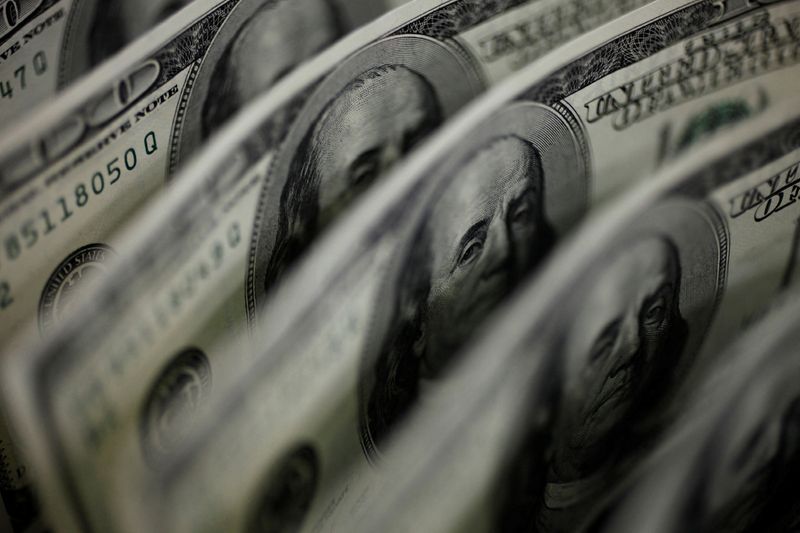
Investing.com — The U.S. dollar steadied on Monday after slumping in the prior week on weaker-than-anticipated nonfarm payrolls data, which led traders to push up the timeline for potential Federal Reserve interest rate cuts this year.
At 04:31 ET (08:31 GMT), the U.S. , which tracks the greenback against a basket of six other currencies, traded 0.04% higher at 105.07.
It had fallen last week to a more than three-week low, a decline fueled by wagers that the Fed may now choose to slash rates from more than two-decade highs as soon as September. Markets were previously betting that the central bank would roll out an initial 25-basis point reduction in November.
The soft payrolls data also put upcoming addresses by a string of key Fed officials this week squarely in focus. On Monday, New York Fed President John Williams and Richmond Fed President Thomas Barkin are both set to speak, followed by Minneapolis Fed President Neel Kashkari a day later. Chicago Fed President Austan Goolsbee and Fed Governor Michelle will make appearances later this week as well.
The euro exchanged hands 0.1% higher at $1.0769. The European Central Bank is widely tipped to roll out its own rate cut in June, although it remains uncertain what will happen with monetary policy after the meeting.
Meanwhile, the British pound traded 0.2% higher at $1.2573. Data last week showed that the U.K.’s key services sector remains in a healthy state, possibly granting the Bank of England more room to delay rate reductions.
remove ads
.
Broader Asian currencies retreated after recently gaining some ground against the dollar. But the prospect of U.S. borrowing costs remaining elevated in the near-term kept most regional currencies trading negative for the year.
The Japanese yen’s pair rose 0.6% on Monday, although trading volumes in the pair were held back by a market holiday in Japan, while the Chinese yuan’s pair fell 0.4%.
The Singapore dollar’s pair advanced 0.1%, while the Indian rupee’s pair edged up 0.1%.
Elsewhere, the Australian dollar’s pair climbed 0.3%, coming close to two-month highs as traders positioned for a Reserve Bank of Australia meeting on Tuesday. While the RBA is expected to keep rates unchanged, it is also expected to strike a hawkish chord after a stronger-than-expected inflation reading for the first quarter.
Forex
Asia FX dips as dollar steadies from payrolls plunge; yen reverses course
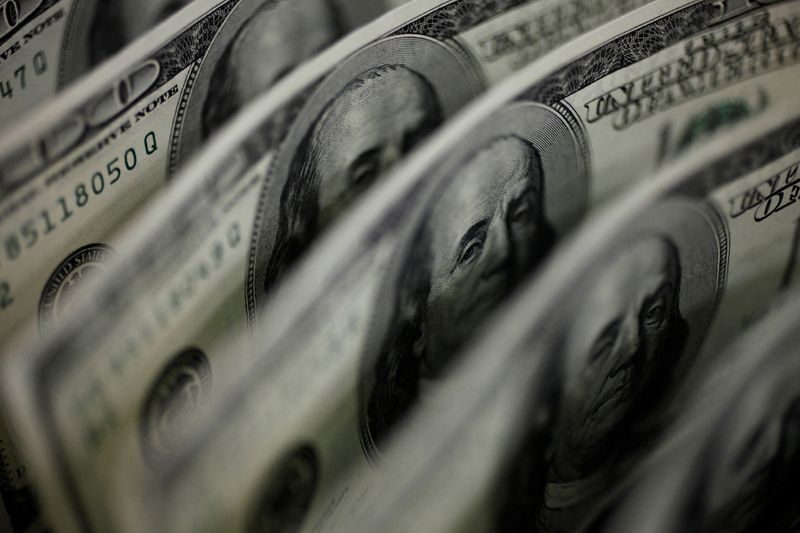
Investing.com– Most Asian currencies weakened on Monday as the dollar steadied from a tumble on Friday after weaker-than-expected payrolls data saw markets ramp up bets on interest rate cuts by the Federal Reserve.
The Japanese yen was the worst performer in Asia, reversing course after apparent government intervention last week saw the currency rebound from 34-year lows.
Most regional currencies were also sitting on strong gains from Friday, following the payrolls reading and the corresponding drop in the dollar. But the greenback found its footing on Monday.
Japanese yen reverses some gains, USDJPY rises
The Japanese yen’s pair rose 0.6% on Monday, although trading volumes in the pair were held back by a market holiday in Japan.
The pair, which is inversely related to strength in the yen, had plummeted from a 34-year high of over 160 yen last week amid signs of repeated government intervention in currency markets.
But given that the underlying factors behind the yen’s weakness- chiefly a large gap between U.S. and local rates- remain in play, bets against the yen persisted.
The USDJPY pair was now close to breaking above 154, with traders also doubting just how much capacity Tokyo had to keep intervening in markets.
Australian dollar strong, AUDUSD up before hawkish RBA
The Australian dollar’s pair rose 0.1% on Monday, coming close to two-month highs as traders positioned for a on Tuesday.
While the RBA is expected to keep rates unchanged, it is also expected to strike a hawkish chord after a stronger-than-expected inflation reading for the first quarter.
remove ads
.
Sticky inflation gives the RBA more impetus to keep rates high for longer, with some analysts suggesting the bank could even hike rates further.
Dollar steadies after payrolls-driven plunge, rate cuts in focus
The and both rose 0.1% in Asian trade after tumbling 0.8% last week. Losses in the greenback came as data read weaker than expected for April.
The data furthered bets that a cooling labor market will give the Federal Reserve more impetus to begin cutting interest rates. The showed traders ramping up their bets for a 25 basis point cut in September.
The soft payrolls data also put upcoming addresses by a string of key Fed officials this week squarely in focus.
Broader Asian currencies retreated after gaining some ground against the dollar last week. But the prospect of U.S. interest rates remaining high in the near-term kept most regional currencies trading negative for the year.
The Chinese yuan’s pair fell 0.4% on Monday in catch-up trade, as onshore yuan trading resumed after a long weekend.
The Singapore dollar’s pair rose 0.2%, while the Indian rupee’s pair rose 0.1% and back towards record highs.
Forex
Dollar drops as employers add fewer jobs than expected in April
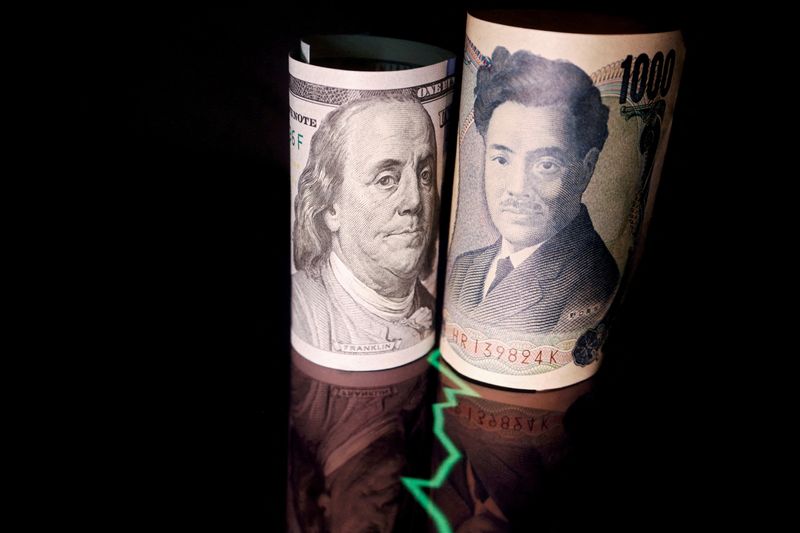
By Karen Brettell
NEW YORK (Reuters) – The dollar fell to a three-week low against the yen on Friday after data showed U.S. jobs growth slowed more than expected in April and annual wage gains cooled, boosting bets that the Federal Reserve will cut rates twice this year.
Employers added 175,000 jobs last month, below economists’ expectations for a 243,000 increase. Wages increased 3.9% in the 12 months through April, below expectations for a 4.0% gain after rising 4.1% in March.
The unemployment rate rose to 3.9% from 3.8%, remaining below 4% for the 27th straight month.
“The data’s soft across the board from the Fed’s perspective,” said Jason Pride, chief of investment strategy and research at Glenmede in Philadelphia.
Fed funds futures traders raised bets that the Fed would cut rates twice this year, with 47 basis points of easing priced in, up from 42 basis points before the data.
“The market at this point is so hoping that the Fed can cut rates this year and did not want one of the hot numbers coming in. Today’s report certainly offers them a cooler read of the labor landscape,” said Quincy Krosby, chief global strategist at LPL Financial (NASDAQ:) in Charlotte.
Still, the report itself is unlikely to sway Fed policy unless the trend continues.
“An unemployment rate of 3.9% is not something disastrous. This indicates an economy that is not declining dramatically, but it definitely indicates a looser labor market,” said Pride. “It gives the Fed some hope, but it does not establish the trend for them.”
remove ads
.
The Fed said after its two-day meeting on Wednesday that sticky inflation meant that it would take longer to cut rates.
Inflation should continue to decline even as the U.S. central bank holds its benchmark interest rate at current levels, Fed Governor Michelle Bowman said on Friday while reiterating her willingness to raise the policy rate if progress peters out or reverses.
The jobs report showed “solid” growth that slowed to a point that could make Fed officials more confident the economy is not overheating, Chicago Fed President Austan Goolsbee said on Friday.
Other data on Friday showed the U.S. services sector contracted in March, while a measure of prices paid by businesses for inputs jumped, a worrisome sign for the inflation outlook.
The was last down 0.27% at 105.03 after reaching 104.52, the lowest since April 10. The euro gained 0.39% to $1.0766.
The greenback weakened 0.48% to 152.9 Japanese yen, reaching as low as 151.86, the weakest since April 10.
The yen surged in light trading late on Wednesday and on Monday, which traders and analysts attributed to intervention by Japanese authorities.
Japanese Finance Minister Shunichi Suzuki said on Friday that authorities may need to smooth any excessive yen moves that hurt households and companies.
The yen is on track for its best weekly percentage gain against the greenback since November 2022, after Japanese authorities also intervened in October 2022 to shore up the currency.
The yen reached a 34-year low of 160.245 on Monday as it suffers from a wide interest rate differential with the dollar.
remove ads
.
In cryptocurrencies, bitcoin gained 5.30% to $61,828.

 Forex2 years ago
Forex2 years agoForex Today: the dollar is gaining strength amid gloomy sentiment at the start of the Fed’s week

 Forex2 years ago
Forex2 years agoHow is the Australian dollar doing today?

 Forex1 year ago
Forex1 year agoUnbiased review of Pocket Option broker

 Forex2 years ago
Forex2 years agoDollar to pound sterling exchange rate today: Pound plummeted to its lowest since 1985

 Cryptocurrency2 years ago
Cryptocurrency2 years agoWhat happened in the crypto market – current events today

 World2 years ago
World2 years agoWhy are modern video games an art form?

 Stock Markets2 years ago
Stock Markets2 years agoMorgan Stanley: bear market rally to continue

 Economy2 years ago
Economy2 years agoCrude oil tankers double in price due to EU anti-Russian sanctions





